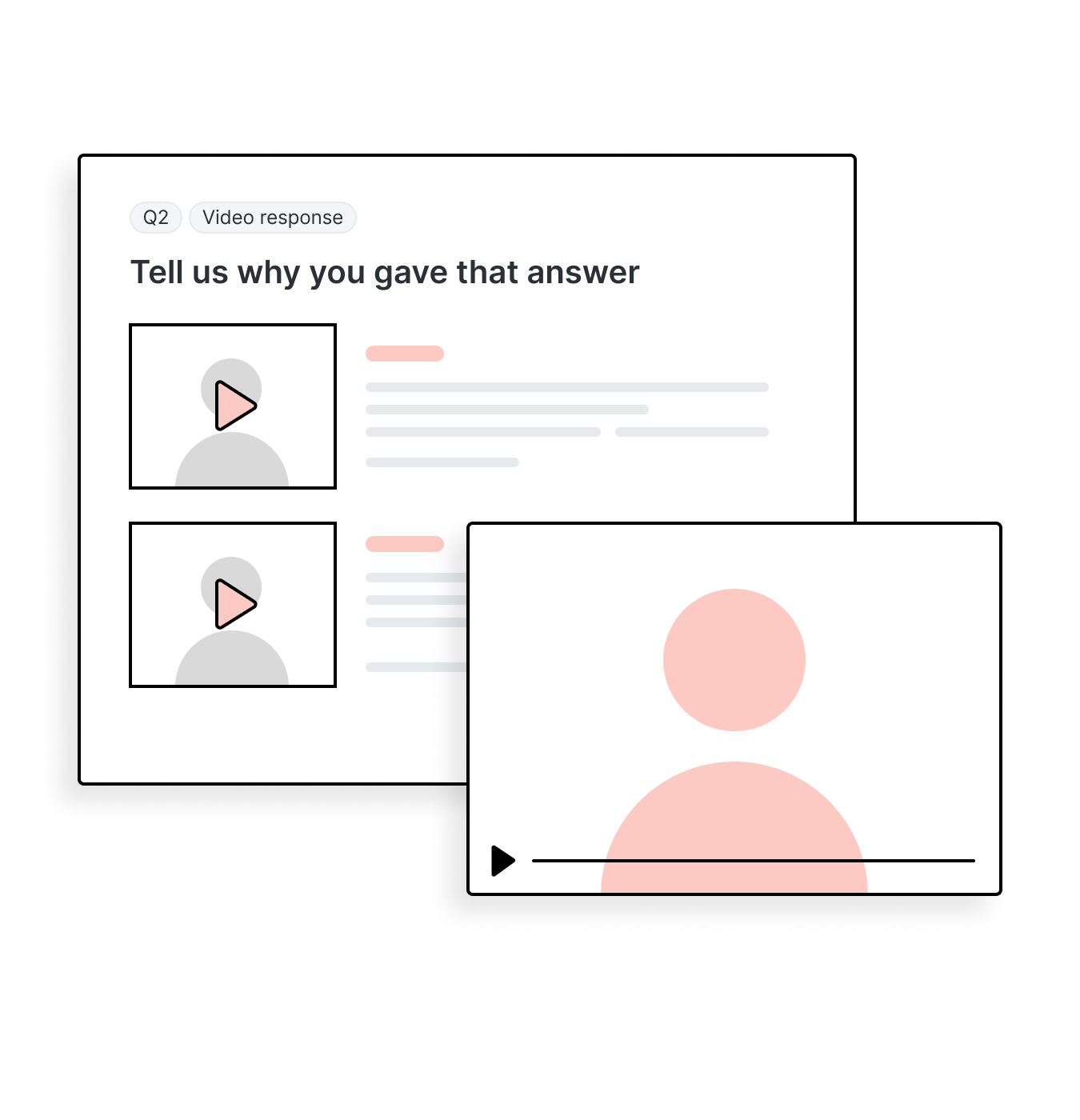25 Qualitative market research questions (and how to write your own)

There’s something very satisfying about being asked a great question that really gets you thinking. And in qualitative market research, it’s especially valuable.
If you ask the right person the right question, you’ll be able to uncover next steps — both small ones and big leaps — that will lead you to a better brand.
If you approach qualitative research right, you can get rich and valuable insights into your customers’ behaviors, and how to play into them.
You’ll learn about how customers interact, their motivations, and how to be there when they need you. And, you’ll uncover things about your brand that are difficult to find out from the inside.
We’re about to show you 25 qualitative research questions across six categories, that will allow you to take a deep dive into your target customers’ brain. These research questions are perfect to use in focus groups or with Attest’s Video Responses feature.
25 Examples of qualitative research questions
Qualitative research questions come in all shapes and sizes. We’ve split them up in several categories to inspire you to mix it up in your next survey or interview and make them work for your choice of qualitative research question types and methods.
Descriptive qualitative research questions
Descriptive questions are effective qualitative research questions that allow participants to describe experiences, opinions and more.
- Describe how this product/service has changed the way you approach [specific task/activity].
This question digs into the tangible impacts of your product on daily life, revealing how it reshapes routines or approaches to tasks.It’s a great way to highlight the practical value and possibly discover unexpected benefits that your product brings to the table. - If you were to introduce this product/service to a friend, what would you say?
Asking this encourages users to put their experience into their words, almost like a personal pitch. It’s a fun and low barrier approach to find out what stands out to them and what they value most about your offering. - What three words would you use to describe this product/service after your first use?
If you’re looking for immediate, instinctive reactions, qualitative research questions like these work best.They allow the user to give a quick snapshot and not have to think long and hard about an answer. Encourage them to respond with the first thing that comes to mind — no wrong answers. - What aspect of this product/service do you think is underrated?
This seeks to uncover hidden gems within your product that may not be getting the spotlight they deserve — even internally.It’s a clever way to find out about features or benefits that might be flying under the radar but have the potential to be major selling points.
Comparative qualitative research questions
Using comparative qualitative research questions you can invite respondents to talk about your brand, product or services in comparison to others. It can help you understand the differences between you and your competitors, from your consumers’ perspective.
These qualitative research questions are a great addition to numbers, scores and other numerical data derived from quantitative research questions in a quantitative study.
- What differences do you notice between this brand and its competitors in terms of value provided?
This question invites customers to think critically about the unique advantages or shortcomings of your product compared to the competition.It’s insightful because it can highlight what customers value most about your brand and whether you are doubling down on the right USPs according to them. - In what situation would you prefer this competitors’ product/service over ours?
Asking this might seem a bit daring, but it’s a golden opportunity to gain honest feedback on where your product may fall short for certain users or use cases.Research questions like this can uncover specific features, price points, or scenarios where competitors have an edge, offering you clear directions for strategic improvements or innovations. - How does the ease of use of this product/service compare to others you have used in the past?
This question zeros in on usability, a crucial aspect of customer satisfaction. It offers direct feedback on how user-friendly your product is compared to others, highlighting areas where you excel or need improvement. - When choosing between this product/service and others, what factor weighs most heavily on your decision?
Understanding the key factors that influence choice can help you fine-tune your offerings and marketing messages to better meet customer needs and preferences.If you look at the answers and compare the marketing efforts of your own brand and main competitors, you’ll be able to spot where you could make improvements. - Can you identify a feature in a competing product/service that you wish ours had?
Sometimes asking what feature they’d love is tricky: it might be hard to dream up. But if you give users the opportunity to shop from your competitors’ features, it might be easier.Qualitative research questions like these are therefore a smart and straightforward way to identify gaps in your product from a user perspective.
Exploratory qualitative research questions
Exploratory qualitative research questions are used in qualitative methods to tap into potential opportunities, and uncover insights that haven’t been previously considered. Add these research questions to your qualitative research studies if you’re on the hunt for new ideas.
- What challenges are you currently facing that this product/service does not address? This question is a gem in qualitative studies because it shines a light on the gaps between what your product offers and what your users actually need.By understanding these challenges, you’re not just guessing; you’re directly addressing the needs that matter most to your users, making every feature more aligned with their real-world problems.
- If you could add any premium features to this product/service, big or small, while the price remains the same, what would it be?
Research questions like these open up a playground for users’ imaginations, allowing you to peek into their deepest wishes.It’s a creative way to use qualitative research to uncover independent variables (new features) that could make your product indispensable. - What would make you stop using this product/service tomorrow?
This one might sound a bit scary, but it’s crucial. It helps you pinpoint the deal breakers that could push your users away.Think of it as a preventive measure; by understanding these thresholds, you can steer clear of them in your future updates or service improvements. This question is a cornerstone in crafting a research design that seeks to minimize risks and maximize satisfaction. - What’s a feature you never knew you needed until you started using this product/service?
These insights are gold for marketing and product development, revealing the unexpected delights that can turn casual users into loyal fans.Plus, it’s a great way to highlight the qualitative words or phrases that resonate most with your audience, giving you a direct line to what makes your product stand out. - If this product/service no longer existed, what would be the biggest gap in your routine or activities?
This qualitative question helps to understand the role your product plays in users’ lives, emphasizing its importance and potential areas for highlighting in marketing efforts.Knowing what would replace you also tells you a great deal about the value your product offers.
Experience-based qualitative research questions
These qualitative research questions focus on the personal experiences of your users, and try to understand their journey and interactions with the product or service deeply.
- Describe a situation where this product/service met or exceeded your expectations.
The feedback from this research question can reveal the “wow” factors that differentiate your offering in the market. It’s a great way to identify the elements of your product or service that surprise and delight customers.These qualitative questions will also highlight the specific words they use for this will also be great to fine-tune your communications and choice of words. You might be describing the right benefits already, but maybe not in the words they relate to most. - What’s missing from your experience with this product/service?
This research question is a direct line to understanding your customers’ unmet needs and desires. It encourages them to share their thoughts on how your product or service could be more useful, enjoyable, or relevant to their lives. - What was your initial impression of this product/service, and how has it evolved?
A classic, but nonetheless a valuable qualitative research question. If peoples’ experiences with your product change their impression of it over time, it’s crucial you dig into what those experiences are, to better match your marketing to the real world.Especially if impressions tend to take a more negative turn after some experiences, but also when it’s the other way around — don’t undersell your product!
Behavioral qualitative research questions
Behavioral qualitative research questions seek to understand the actions and behaviors of consumers, particularly in relation to your product or service. Adding these to your qualitative study will make it more relevant to daily life applications.
- Have you been using products/services like ours in ways that you didn’t think you would initially?This is a good qualitative research question to learn about unconventional or alternative use cases of your product. Of course, it doesn’t mean you immediately need to pivot, but it can help you map out uncharted or ignored territory and find fans in niche parts of your market.
- Has this product/service replaced something else you used to rely on? If so, what?
We’re going there: ask about the ”ex”. Knowing who or what came before you and why things didn’t work out will help you be better in many ways. So, make sure to follow up this question with another one digging into the reasons for the break-up. - What activity or task do you most frequently pair with this product/service?
This might not seem immediately relevant, but it can tell you a great deal about your customer’s behavior. Knowing what place you have in their routine or what products they combine yours with can help you uncover big possibilities for innovations or even partnerships. - How has this product/service influenced your daily habits or routines?
This question doesn’t just focus on the functional benefits of your product, but also how those manifest in someone’s daily life. Do people highlight time they won back, or pleasure gained? Have they made any other changes that are relevant to you? There’s a lot to learn from small habit changes!
Emotional qualitative research questions
These qualitative questions explore the emotional connections and reactions participants have towards a particular topic, product, service, or brand. The qualitative questions examples below specifically bring a human side to quantitative research.
- How does this product/service fit into the moments that matter most to you?
This might not be interesting for every product or brand, but if your brand is aiming to significantly impact people’s lives and important moments, this is a must-ask. Are they taking your products along to big moments in their lives? Does it provide them with comfort, confidence or something else when they need it? Research questions like this go way beyond functionality and tap into emotional significance — which is great for brands who really want to integrate with people’s lives. - How does using this product/service make you feel compared to not using it at all?
Are people frustrated when they run out of your product? Sad? Do they miss it at all? This question can reveal some powerful feelings around your product. - How does this product/service affect your mood?
This is a fun question to ask and can give you a great insight into what emotions your product evokes in general. Maybe some people don’t think about how they feel with your product, but others might get a confidence boost out of it, or chuckle every time they read your product copy. This question can reveal teeny tiny details that could matter a lot.
How to write your own insightful qualitative market research questions
Got a burning question? Here’s how to make it part of a successful qualitative research project.
1. Set clear objectives
Knowing why you’re asking something is what helps you ask it the right way. Ask yourself what your general research objective is and how each of your qualitative research questions helps you get to the main answer.
Whether you’re looking for insights for your food brand, or market research for the automotive industry, the principle is the same…
For every qualitative research question you ask, find out IF it leads you closer to your goals, and make sure you can explain HOW it does so.
2. Ask open-ended questions the right way
There’s an art in asking great open-ended questions. Here’s an example of both seemingly similar open-ended, qualitative research questions, but one’s good, and one’s not:
“Why do you think people say this new smartwatch is better than others on the market?”
“What feedback are you hearing about this smartwatch in comparison to other smartwatches you know?”
The first one already works with the assumption and bias that your product is great. You’re practically putting words into your respondent’s mouth/answer box. The next one lets them come up with their own, unbiased response.
Good qualitative research questions should be:
- Unbiased: avoid qualitative research questions that are leading or show any form of bias whatsoever.
- Clear: only ask one thing at a time, and make it clear what that actually is.
- Relevant: make sure your question makes sense. Not just in the whole qualitative research, but also in the place it has in your survey or interview.
- Truly open: some quantitative research questions are sometimes disguised as qualitative research questions. Make sure yours is truly open and qualitative.
If you tick these boxes, your respondents will feel encouraged to express their opinions and motivations freely, which in turn will add depth and context to your research findings.
3. Balance between structured questions and flexibility
Let’s talk about flow. Imagine the panic that would set in if your first question in a job interview would be ”and how do you tackle problems with coworkers?”
Timing matters. Mixing up the question matters. This will create a great flow and keep respondents engaged and enthusiastic, and will avoid confusion.
Make sure to give respondents space to add comments or feedback where needed, but do so in a structured way, so your data remains easy to analyze.
4. Take measures to avoid survey bias
We’re circling back to bias for a second, but just because there’s more to be said and done. Avoiding bias in your surveys and qualitative research questions isn’t just about avoiding certain words or biased language, it also helps to choose a well-mixed and representative audience. On top of that, make sure your survey churns out high-quality data, not just high-volume. Read more about how we work on keeping your data in great shape.
5. Conduct pilot testing before launching large surveys
Do a mic-check before you send your qualitative research survey out to thousands of people. With pilot testing, you make sure your survey’s research questions are as-to-the-point as you hoped it to be. Send it to a small slice of your total audience, but make sure that the pilot group is just as representative as the total one will be.
Ask the right qualitative market research questions to the correct audience
When you hit that sweet spot of the right qualitative research questions and a perfectly represented audience, the feedback you receive from qualitative research isn’t just data—it’s a roadmap to deeper understanding and connection with your audience. For those looking to dive into the rich world of conducting qualitative research, Attest offers the market research tools and audience reach you need to make every question count. Check out how Attest can help bring your qualitative research to life.
Tell us what you think of this article by leaving a comment on LinkedIn.
Or share it on:


